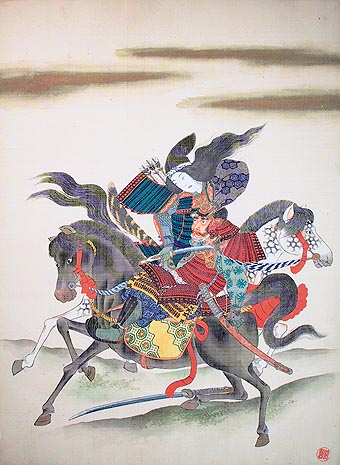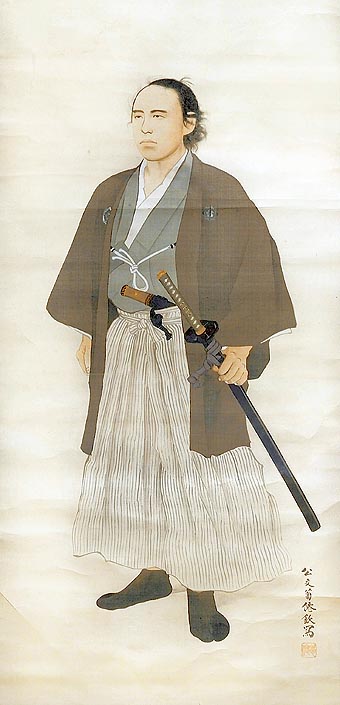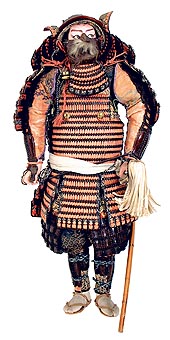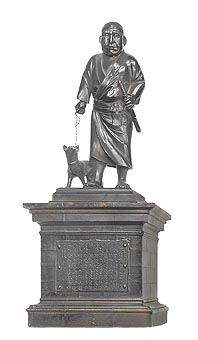 |
|||||||||||||||||
|
|||||||||||||||||
|
In English |
|

Samurais are popular in the western world right now, thanks to Tom Cruise and his box office hit The Last Samurai. Professor of general history at the University of Oulu, Olavi K. Fält is in Finland a pioneer of Japan studies. He says that the first Japan boom resembling the current one started about a hundred years ago, when the small Japan triumphed over the mighty Russia. The familiar image of a samurai as a warrior not afraid of death is based on the ideal created in the Tokugawa era (1600-1868). According to Fält, bushido (way of the warrior) was an artificial structure. It was created, paradoxically, during the longest period of peace in world history, in order to maintain peace in the society and to support the military regime, bakufu.
 Sakamoto Ryoma, 'The First Samurai' |
EDUCATION Kaltio 3/04 Finnish text: Päivi Parhi-Riikola
A Samurai doll
 The samurai culture began to form in the 8th century, when Japanese society was being remodelled on the Chinese one, based on a strong central government. All of the land was governed by the emperor who gave his people land according to their family size and achievements in the society. The imperial army was funded with taxes collected from the countryside. However, the favourites of the imperial court also received land as a reward for their high appointments or substantial social achievements. As a consequence, free landownership went up rapidly, and the emperor was forced to increase taxes. Many small landowners handed their land over to big owners and a bond of loyalty developed between them. As the tax income diminished, the government was not able to maintain the army. By the 900s, private samurai cliques, mainly comprised of small farmers that protected the big owners' farms, formed the most important war powers. The big landowners, related to the emperor, became the real rulers of the country. Some of the first influential samurai families were Minamoto and Taira. The power struggle between them eventually led to the victory of Minamoto and to the first military regime, Kamakura shogunate (1192-1333).
|
|
The government officials of the samurai rule adopted the ideal of civilization from the imperial court culture, so they can in fact be regarded as parvenu imitators of the court. For instance, the samurais adopted the Japanese poetry tradition, sumo wrestling which, according to tradition, began before Christ, Confucianism, based on a strict patriarchal hierarchy, and another Chinese religion, Zen Buddhism, which spread to Japan in the 12th and 13th centuries. Although we consider the samurai culture hard and masculine, many forms of art developed by it seem very soft and feminine. The most important of these is the tea ceremony, 'the way of the tea', which Toyotomi Hideyoshi, known for his fondness for tea, settled as a part of samurai culture in the 16th century from Zen Buddhism. Strict rules bound the movements, gestures and speech of those who took part in the ceremony; these rules freed the participants from observing their own behaviour and increased the sense of community and peace of mind. Calligraphy and ikebana also represent the peaceful tradition of the samurai culture. The latter sprang from the metaphorical sacrificial flower arrangements built by Buddhist monks in the temples. With the influence of Zen philosophers and samurais, the arrangements got simpler and smaller. Ikebana as a pastime was allowed only for men up until the 1860s.
Even though women were rather invisible during the samurai period, and even if they were, especially within ruling families, basically homebound, women had a significant part in the development and preservation of Japanese culture. In the 18th century, the literacy of Japanese women and men was one of the best in the world, and basically everyone who belonged to the samurai class knew how to read. The women also took part in wars, albeit in disguised roles. The wives of daimions, feudal lords, defended large castles in fire-proof combat suits, and some warriors had female bodyguards and personal aids on the battlefield. 
Officially, the samurai class was only born in the Tokugawa era (1600-1868), when the samurais defined it their task to maintain peace and order within the empire. This task was justified with the words of Confucian philosopher Mengtz: "There are those who use their brain and those who use their muscles. The former govern, the latter are governed. Those who govern get their living from those who are governed." The centrality of education is seen in the samurai's other name bushi, the gentleman warrior. The most important traits of a civilized warrior were rightfulness, sense of duty, courage, mercifulness, politeness, honesty, and loyalty. These ideals fit well with the Christian sense of morality. The words of the philosopher Mengtz contain the reason for the breakup of the samurais' position of power. The Samurai received their income in rice bursaries. When the price of rice dropped during the long period of peace, the urbanised samurais got poorer and had to borrow money from the merchants who had quickly gotten rich in the city. The Samurai despised the profession of merchants; for they were merely intermediaries who did not produce anything themselves. When more and more city samurais had to rely on mercantilism and handicrafts to survive, the tradition began to disintegrate. When the military regime could not anymore respond to Japan's inner and outer challenges, many samurais took part in ousting it at the end of 1860s. One of the most highly regarded reformative samurais was Sakamato Ryoma, who was assassinated by his former city friends in 1867. He was nicknamed the First Samurai. The samurais' spiritual tradition and idealization of education held a key position in the astounding rise and success of modern Japan.
Under today's Japanese businessman's suit, can there thus be found a samurai's mental guard? Just a few years ago, the hierarchy of large Japanese companies still resembled the structures of the samurai era. The bond of loyalty between the employer and the employee was a life-long one. However, with the economic globalisation the bond of loyalty is about to be broken. Saigo Takamori's memorial still stands in one of Tokyo's central parks, reminding people that the most important thing for a human being is to act with a pure heart. But what does reveal the fact that a similarly magnificent statue has been erected to commemorate an even more mythical Japanese creature, Godzilla? |
|

 Saigo Takamori
Saigo Takamori